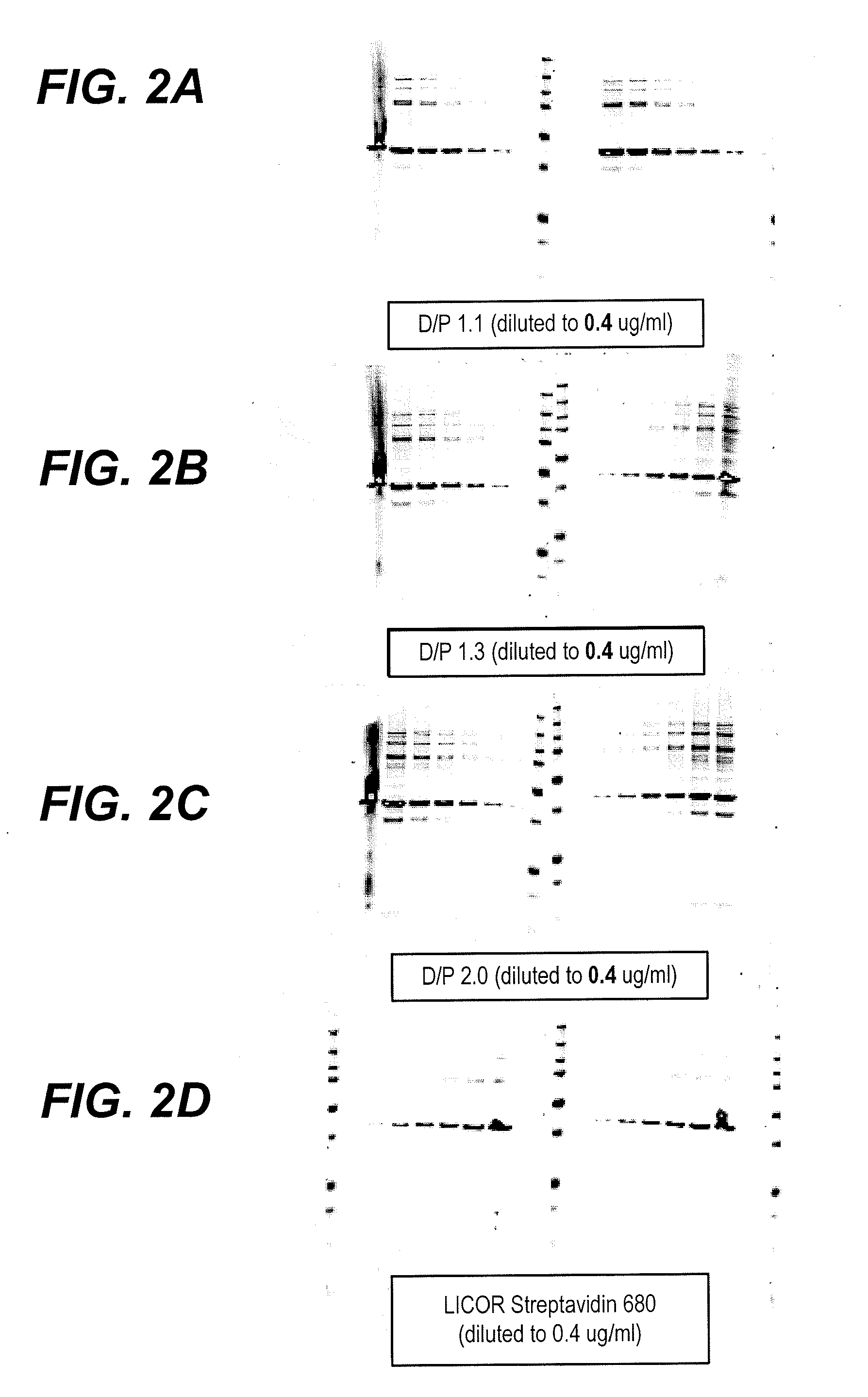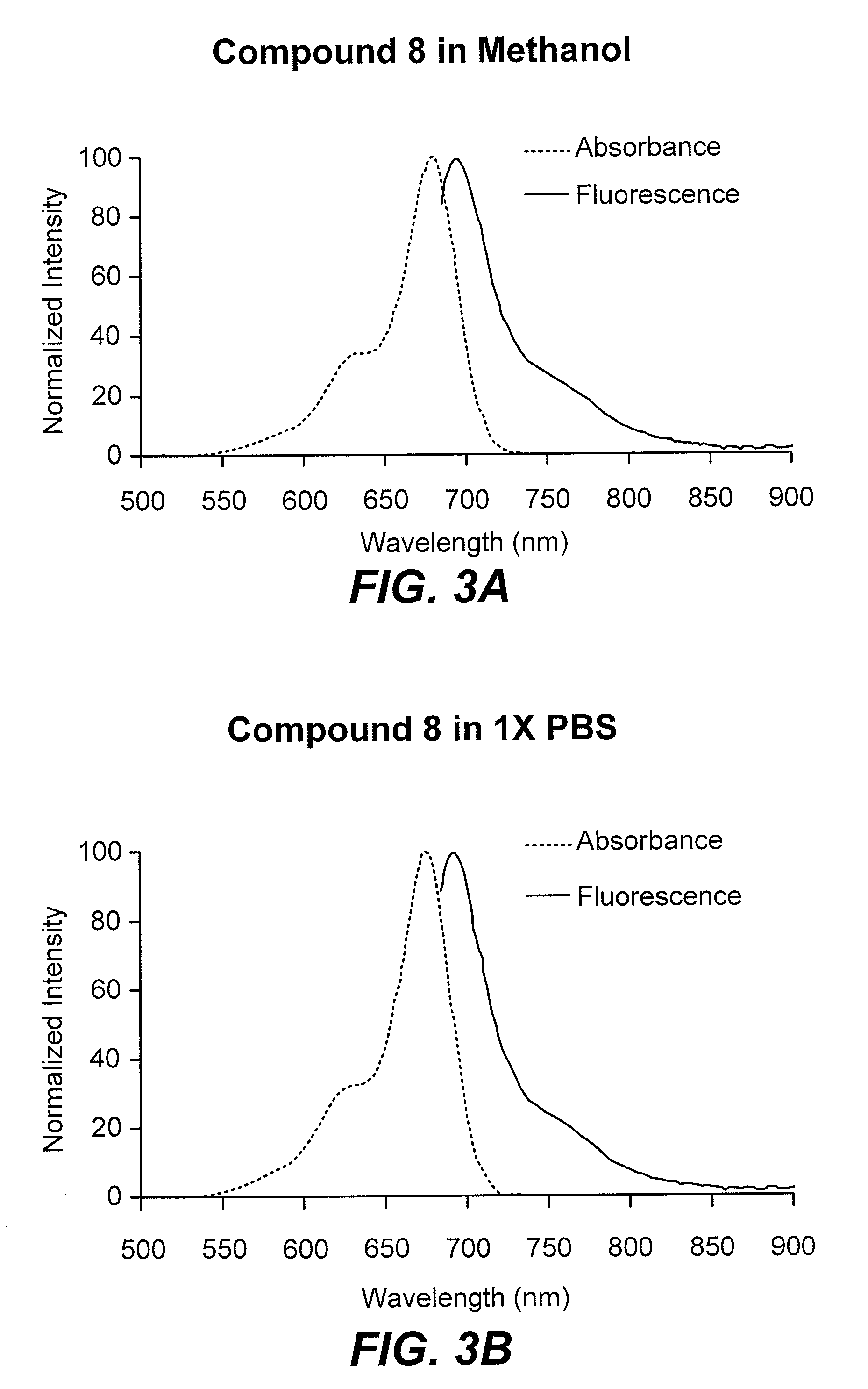Fluorescent imaging with substituted cyanine dyes
a technology of cyanine dyes and fluorescence imaging, which is applied in the direction of instruments, drug compositions, immunological disorders, etc., can solve the problems of difficult high purity and yield high-purity and yield high, the stability of known cyanine dyes is not good, and the cyanine dyes lack the thermal stability and photostability that is necessary
- Summary
- Abstract
- Description
- Claims
- Application Information
AI Technical Summary
Problems solved by technology
Method used
Image
Examples
example 1
Preparation of 6-Hydrazino-1,3-naphthalene Disulfonated Salt
[0227]
6-Hydrazino-1,3-naphthalene Disulfonated Salt (1)
[0228]6-Amino-1,3-naphthalene disulfonate disodium salt (25 g, 72 mmol) was dissolved in 150 ml of water and added to 50 ml of concentrated hydrochloric acid. The slurry was cooled to about 0° C. in an ice / salt bath, and sodium nitrite (5.46 g, 79.2 mmol) was added in 25 ml of cold water dropwise over 10 minutes. Stannous chloride (20.42 g, 108 mmol) was dissolved in 15 ml concentrated hydrochloric acid, cooled to 0° C. and added to the reaction mixture over 20 minutes. The resulting solution was allowed to warm to room temperature with stirring over 3 hours. The solution was reduced in volume by rotary evaporation, and the product was precipitated by the addition of isopropanol. Compound 1 was filtered, washed with isopropanol, and dried under vacuum.
example 2
Preparation of 2,3,3-Trimethylbenzindole-6,8-disulfonate Salt
[0229]
2,3,3-Trimethylbenzindole-6,8-disulfonate Salt (2)
[0230]6-Hydrazino-1,3-naphthalene disulfonated salt 1 (10 g, 25 mmol), isopropyl methyl ketone (12 g, 140 mmol) and potassium acetate (6 g, 61 mmol) were combined in 75 ml glacial acetic acid and heated to 145° C. for 22 hours. The solution was cooled, and the acetic acid was removed by rotary evaporation. The residue was dissolved in methanol and filtered. The compound 2 was then precipitated from the methanol filtrate with isopropanol, filtered, washed with isopropanol and ether, and dried under vacuum.
example 3
Preparation of Sodium 1,1,2-Trimethyl-3-(3-sulfonatopropyl)-1H-benzo[e]indolium-6,8-disulfonate
[0231]
Sodium 1,1,2-Trimethyl-3-(3-sulfonatopropyl)-1H-benzo[e]indolium-6,8-disulfonate (3)
[0232]2,3,3-Trimethylbenzindole-6,8-disulfonate 2 (2.2 g, 5 mmol) was stirred in 50 ml of dry 1,2-dichlorobenzene. 1,3-propanesultone (2.8 g, 23 mmol) was added, and the solution was heated to 145° C. in a sealed tube for 15 hours. The solution was cooled, and the solvent was decanted off The solid product 3 was washed on a filter with three 50 ml portions of isopropanol followed by 50 ml of ether and dried under vacuum, resulting in a dark purple solid (2.5 g, 90%).
PUM
| Property | Measurement | Unit |
|---|---|---|
| wavelength | aaaaa | aaaaa |
| wavelength | aaaaa | aaaaa |
| wavelength | aaaaa | aaaaa |
Abstract
Description
Claims
Application Information
 Login to View More
Login to View More - R&D
- Intellectual Property
- Life Sciences
- Materials
- Tech Scout
- Unparalleled Data Quality
- Higher Quality Content
- 60% Fewer Hallucinations
Browse by: Latest US Patents, China's latest patents, Technical Efficacy Thesaurus, Application Domain, Technology Topic, Popular Technical Reports.
© 2025 PatSnap. All rights reserved.Legal|Privacy policy|Modern Slavery Act Transparency Statement|Sitemap|About US| Contact US: help@patsnap.com



